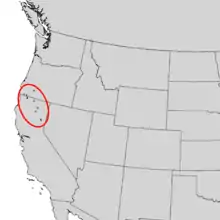| Cupressus bakeri | |
|---|---|
 | |
| Scientific classification | |
| Kingdom: | Plantae |
| Clade: | Tracheophytes |
| Clade: | Gymnospermae |
| Division: | Pinophyta |
| Class: | Pinopsida |
| Order: | Cupressales |
| Family: | Cupressaceae |
| Genus: | Cupressus |
| Species: | C. bakeri |
| Binomial name | |
| Cupressus bakeri Jeps. 1909 | |
 | |
| Natural range | |
| Synonyms[2] | |
| |
Cupressus bakeri, reclassified as Hesperocyparis bakeri,[3][4][5] with the common names Baker cypress, Modoc cypress, or Siskiyou cypress, is a rare species of cypress tree endemic to a small area across far northern California and extreme southwestern Oregon, in the western United States.
Description

The evergreen tree has a conic crown, growing to heights of 9–25 meters (30–82 ft),[6] exceptionally to 39 m (130 ft), and a trunk diameter of up to 50 centimeters (20 inches), exceptionally to 1 m (40 in). The bark is thin, red when young, and gray in maturity.[6]
The foliage grows in sparse, very fragrant, usually pendulous sprays, varying from dull gray-green to glaucous blue-green in color. The leaves are scale-like, 2–5 millimeters long, and produced on rounded (not flattened) shoots.[7]
The seed cones are globose to oblong, covered in warty resin glands, 10–25 mm (3⁄8–1 in) long, with 6 or 8 (rarely 4 or 10) scales, green to brown at first, maturing gray or gray-brown about 20–24 months after pollination. The male cones are 3–5 mm long, and release pollen in February–March.[8]
Distribution and habitat
The tree grows in limited populations in southwestern Oregon's Josephine and Jackson counties, and slightly more populously in a small section of Northern California within Siskiyou, Modoc, Shasta, Plumas and Tehama counties.[9] It is probably the northernmost cypress.[6]
It is usually found in small, scattered populations, not in large forests, at altitudes of 900–2,000 m (3,000–6,600 ft). This includes locales in the Modoc Plateau, southern Cascade Range, Klamath Mountains, and northern Sierra Nevada.[10] It is slow-growing in the wild, and is mostly restricted to sites difficult for plant growth, on serpentine soils and on old lava flows. Its tolerance of these sites enables it to avoid competition from much faster-growing trees. It is found in chaparral and yellow pine forest habitats.[5]
Ecology
The tree's thin bark makes it susceptible to wildfire, exposure to which is required to release the seeds; these then colonize the scorched earth left behind.[6] Fire suppression policies of the past decades have severely limited reproduction of the species. It is listed as a vulnerable species on the IUCN Red List.[11]
See also
- Flora of the Klamath Mountains
- List of plants on the Modoc National Forest
- Milo Samuel Baker
- Rogue River-Siskiyou National Forest
References
- ↑ Farjon, A. (2013). "Cupressus bakeri". IUCN Red List of Threatened Species. 2013: e.T34047A2841226. doi:10.2305/IUCN.UK.2013-1.RLTS.T34047A2841226.en. Retrieved 12 November 2021.
- ↑ The Plant List, Cupressus bakeri Jeps.
- 1 2 USDA: Hesperocyparis bakeri . accessed 8.28.2015.
- ↑ Jepson eFlora (JM2): Hesperocyparis bakeri . accessed 8.28.2015.
- 1 2 CalFlora Database: Hesperocyparis bakeri . accessed 8.28.2015.
- 1 2 3 4 Arno, Stephen F.; Hammerly, Ramona P. (2020) [1977]. Northwest Trees: Identifying & Understanding the Region's Native Trees (field guide ed.). Seattle: Mountaineers Books. pp. 180–181. ISBN 1-68051-329-X. OCLC 1141235469.
- ↑ Pinetum Photos, trees
- ↑ Pinetum Photos, cones
- ↑ United States Department of Agriculture plants profile
- ↑ Jepson Manual, University of California
- ↑ Farjon, A. (2013). "Cupressus bakeri". IUCN Red List of Threatened Species. 2013: e.T34047A2841226. doi:10.2305/IUCN.UK.2013-1.RLTS.T34047A2841226.en. Retrieved 12 November 2021. – Listed as Vulnerable (VU B1+2bcd v2.3)
External links
- CalFlora Database: Hesperocyparis bakeri (Baker's cypress)
- Jepson Manual eFlora (JM2) treatment of Hesperocyparis bakeri
- USDA Plants Profile for Hesperocyparis bakeri (Modoc cypress)
- Gymnosperm Database: Cupressus bakeri
- photo of herbarium specimen at Missouri Botanical Garden, collected in 1934 in Siskiyou County, California
- UC Calphotos Photos Gallery: Hesperocyparis bakeri
(Hesperocyparis bakeri).
